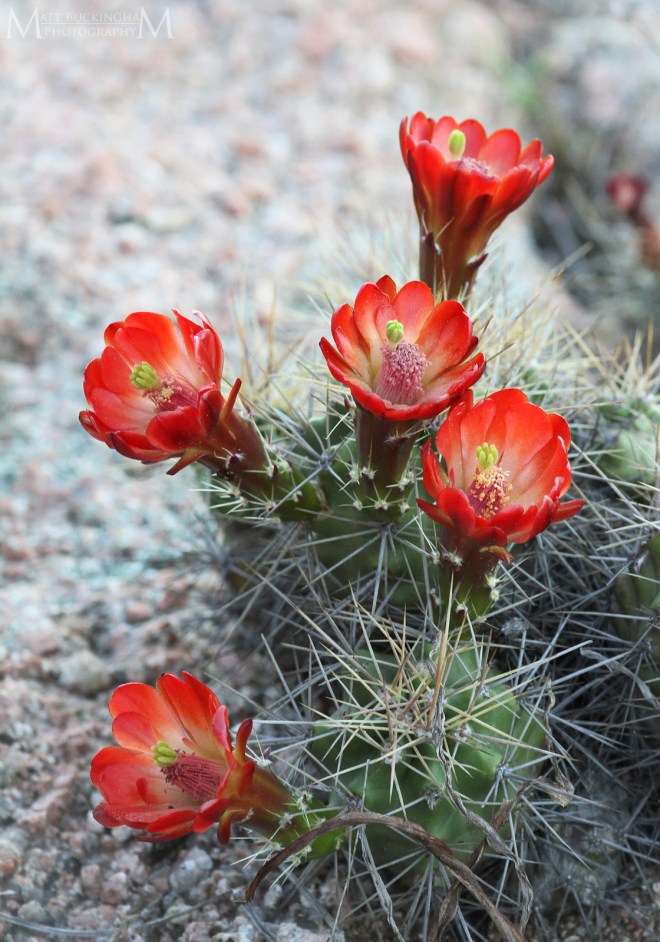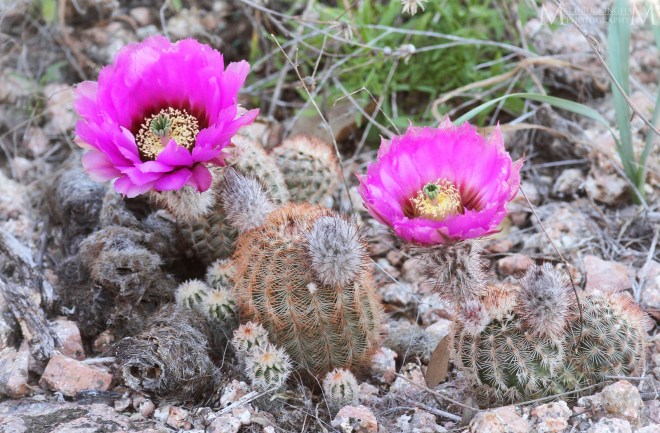Target Species: Claret Cup Cactus (Echinocereus coccineus)

Claret Cup Cactus and Fairy Swords
The Claret Cup Cactus (Echinocereus coccineus) is one of the few species on my list that Carolina really wanted to see. Though she almost always accompanies me on my adventures into the natural world, and her eagle sharp vision usually spots my targets before I do, she is usually just following my lead. Ironically, I was far more successful at spotting the bright scarlet blooms of this cactus than she was – a significant divergence from the norm.
Also known as the Scarlet Hedgehog Cactus, Echinocereus coccineus is a species of the desert southwest that reaches the eastern edge of its range in the Edward’s Plateau of central Texas. Carolina and I were thinking about a quick getaway for our Anniversary, and settled on this beautiful region. We camped at some of the many state parks in the area, and spent our Anniversary rock hounding and plant hunting.

Claret Cup Cactus Flower Detail
I first saw this species over a decade ago when backpacking in the Hill Country. It was in bloom among the limestone bluffs northwest of San Antonio. I had an early point-and-shoot camera with me at the time, and did capture some photos, however I have since wanted to return with my current knowledge and photographic skill set.

A Claret Cup Cactus takes root in a crevice in a large granite outcrop.
This time we found them blooming among crevices and at the base of large rocks in extensive granite outcrops. While many species show preference for either limestone or granite, the Claret Cup seems able to thrive in both. The cacti were often forced to share their preferred growing sites with other plant species seeking a refuge from the inhospitable conditions on the exposed granite. Most notably was the arid country fern known as Fairy Swords (Cheilanthes lindheimeri).
The flowers of Echinocereus coccineus are unique for a couple of reasons. Unlike most other members of the genus Echinocereus, whose flowers close at night and reopen in the morning, the flowers of E. coccineus apparently remain open 24-hours a day, lasting a few days. And while most cacti are pollinated by insects, the Claret Cup is primarily pollinated by hummingbirds.

Claret Cup Cactus and Fairy Swords
One day I would like to photograph the Claret Cup in the high Chisos of Big Bend National Park, however for now I was thrilled to have the chance to capture them near the eastern edge of their range. It was a truly incredible thing to see them growing from what little soil was able to develop among a seemingly endless sea of granite.

Claret Cup Cactus
There were other cacti among the granite as well. I had really hoped to see a Lace Cactus (Echinocereus reichenbachii) in bloom. After a few days of finding lots of plants and no blooms, we finally found a few blooms, some within a stone’s throw of the Claret Cups. Looking at the spines of Lace Cactus, it is easy to see how it earned its name.

Lace Cactus

Lace Cactus
Fairy Swords were abundant, seemingly envigorated by recent rains. The combination of the gray-green ferns and lichen stained boulders was truly beautiful.

Fairy Swords
In deeper depressions within the granite outcrops where debris was able to collect and deeper soils could form species such as Texas Paintbrush (Castilleja indivisa) and Texas Bluebonnet (Lupinus texensis) were able to take hold and thrive. While both species are exceedingly abundant, and often planted along roadways throughout much of the state, it was a thrill to see them growing in their natural habitat.

Texas Paintbrush and Texas Bluebonnets

Texas Bluebonnets
Another common species of the granite outcrops that was also found growing alongside the Claret Cup Cactus was the Giant Spiderwort (Tradescantia gigantea). This species really lived up to its name, reaching heights of nearly 3 feet. This species occurs primarily in the Texas Hill Country, with a few disjunct populations in northeast Texas and parts of Louisiana.

Giant Spiderwort

Giant Spiderwort with Claret Cup Cactus in the background
There was more than plants among the outcrops. We saw many animals including Rock Squirrels (Spermophilus variegatus), Crevice Spiny Lizards (Sceloporus poinsettii), and a Texas Patchnose Snake (Salvadora grahamiae), but as is often the case, I was unable to capture any of these on film. The scenery alone was worth the trip, however. There is something magical about these granite monoliths and the flora and fauna that eke out a living around them. As night fell we laid on flat slab of granite, still warm from the day’s sun, and looked up at the brilliant stars. We pondered life’s questions, big and small, and reveled in the magic of the Texas Hill Country.

Hill Country Magic
